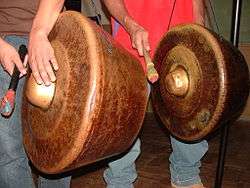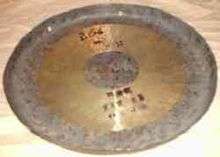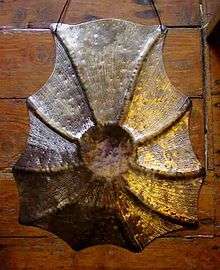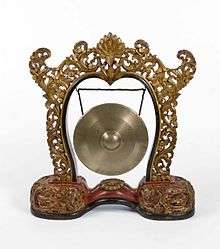Gong
A gong[note 1] is an East and Southeast Asian musical percussion instrument that takes the form of a flat, circular metal disc which is hit with a mallet.
| Gamelan ensemble | |
|---|---|
| Stylistic origins | Music of Indonesia ( Java and Bali ) |
| Cultural origins | Indonesia |
| Typical instruments | Gamelan • Gong • Bonang • Gambang • Gendèr • Kemanak • Kendang • Kepyak • Reyong • Gangsa • Kenong/Kethuk • Peking • Saron • Siter • Slenthem • Suling |

The gong's origin is likely China's Western Regions, sixth century; the term gong originated in Indonesian island of Java. Scientific and archaeological research has established that Burma, China, Indonesia (Java) and Annam were the four main gong manufacturing centres of the ancient world.[1] The gong found its way into the Western World in the 18th century when it was also used in the percussion section of a Western-style symphony orchestra. A form of bronze cauldron gong known as a resting bell was widely used in ancient Greece and Rome, for instance in the famous Oracle of Dodona, where disc gongs were also used.[2][3]
Gongs broadly fall into one of three types: Suspended gongs are more or less flat, circular discs of metal suspended vertically by means of a cord passed through holes near to the top rim. Bossed or nipple gongs have a raised centre boss, or knob, and are often suspended and played horizontally. Bowl gongs are bowl-shaped and rest on cushions. The latter may be considered a member of the bell category. Gongs are made mainly from bronze or brass but there are many other alloys in use.
Gongs produce two distinct types of sound. A gong with a substantially flat surface vibrates in multiple modes, giving a "crash" rather than a tuned note. This category of gong is sometimes called a tam-tam to distinguish it from the bossed gongs that give a tuned note. In Indonesian gamelan ensembles, some bossed gongs are deliberately made to generate in addition a beat note in the range from about 1 to 5 Hz. The use of the term "gong" for both these types of instrument is common.
Types
Suspended gongs are played with hammers and are of two main types: flat faced discs either with or without a turned edge, and gongs with a raised centre boss. In general, the larger the gong, the larger and softer the hammer. In Western symphonic music, the flat faced gongs are generally referred to as tam-tams to distinguish them from their bossed counterparts. Here, the term "gong" is reserved for the bossed type only. The gong has been a Chinese instrument for millennia. Its first use may have been to signal peasant workers in from the fields, because some gongs are loud enough to be heard from up to 5 miles (8 km) away. In Japan, they are traditionally used to start the beginning of sumo wrestling contests.
Large flat gongs may be 'primed' by lightly hitting them before the main stroke, greatly enhancing the sound and causing the instrument to "speak" sooner, with a shorter delay for the sound to "bloom". Keeping this priming stroke inaudible calls for a great deal of skill. The smallest suspended gongs are played with bamboo sticks or even western-style drumsticks. Contemporary and avant-garde music, where different sounds are sought, will often use friction mallets (producing squeals and harmonics), bass bows (producing long tones and high overtones), and various striking implements (wood/plastic/metal) to produce the desired tones.
Rock gongs are large stones struck with smaller stones to create a metallic resonating sound.
Traditional suspended gongs
Chau gong (Tam-tam)

By far the most familiar to most Westerners is the chau gong or bullseye gong. Large chau gongs, called tam-tams[4] have become part of the symphony orchestra. Sometimes a chau gong is referred to as a Chinese gong, but in fact, it is only one of many types of suspended gongs that are associated with China. A chau gong is made of copper-based alloy, bronze, or brass. It is almost flat except for the rim, which is turned up to make a shallow cylinder. On a 10-inch (25 cm) gong, for example, the rim extends about 1⁄2 inch (1 cm) perpendicular to the surface. The main surface is slightly concave when viewed from the direction to which the rim is turned. The centre spot and rim of a chau gong are left coated on both sides with the black copper oxide that forms during manufacture; the rest is polished to remove this coating. Chau gongs range in size from 7 to 80 inches (18 to 203 cm) in diameter.
The earliest Chau gong is from a tomb discovered at the Guixian site in the Guangxi Zhuang Autonomous Region of China. It dates from the early Western Han Dynasty. Gongs are depicted in Chinese visual art as of the 6th Century CE,[5] and were known for their very intense and spiritual drumming in rituals and tribal meetings.[6] Traditionally, chau gongs were used to clear the way for important officials and processions, much like a police siren today. Sometimes the number of strokes was used to indicate the seniority of the official. In this way, two officials meeting unexpectedly on the road would know before the meeting which of them should bow down before the other.
Use of gongs in symphony orchestras
The tam-tam was first introduced as an orchestral instrument by François-Joseph Gossec in 1790, and it was also taken up by Gaspare Spontini and Jean-François Le Sueur.[7] Hector Berlioz deployed the instrument throughout his compositional career, and in his Treatise on Instrumentation he recommended its use "for scenes of mourning or for the dramatic depiction of extreme horror."[7] Other composers who adopted the tam-tam in the opera house included Gioachino Rossini, Vincenzo Bellini, and Richard Wagner;[8] Rossini in the final of act 3 of Armida (1817),[9] Bellini in Norma (1831) and Wagner in Rienzi (1842). Within a few decades the tam-tam became an important member of the percussion section of a modern symphony orchestra. It figures prominently in the symphonies of Peter Ilyich Tchaikovsky,[10] Gustav Mahler,[11] Dmitri Shostakovich[12] and, to a lesser extent, Sergei Rachmaninov and Sergei Prokofiev. Giacomo Puccini used gongs and tam-tams in his operas. Igor Stravinsky greatly expanded the playing techniques of the tam-tam in his The Rite Of Spring to include short, quickly damped notes, quick crescendos, and a triangle beater scraped across the front of the instrument. Karlheinz Stockhausen used a 60" Paiste tam-tam in his Momente.
Nipple gong

A nipple gong has a central raised boss or nipple, often made of different metals than other gongs with varying degrees of quality and resonance. They have a tone with less shimmer than other gongs, and two distinct sounds depending on whether they are struck on the boss or next to it. They are most often but not always tuned to various pitches.
Nipple gongs range in size from 6 to 20 inches (15 to 51 cm) or larger. Sets of smaller, tuned nipple gongs can be used to play a melody.
Nipple gongs are used in Chinese temples for worship and Buddhist temples in Southeast Asia.
These are the primary gong in the traditional Philippine music of kulintang.
In Indonesian gamelan ensembles, instruments that are organologically gongs come in various sizes with different functions and different names. For example, in the central Javanese gamelan, the largest gong is called gong ageng, ranges in size up to 1 meter in diameter, has the deepest pitch and is played least often; the next smaller gong is the gong suwukan or siyem, has a slightly higher pitch and replaces the gong ageng in pieces where gong strokes are close together; the kempul is smaller still, has a higher pitch, and is played more frequently. The gong ageng and some gong suwukan have a beat note.
Opera gongs
An essential part of the orchestra for Chinese opera is a pair of gongs, the larger with a descending tone, the smaller with a rising tone. The larger gong is used to announce the entrance of major players or men and to identify points of drama and consequence. The smaller gong is used to announce the entry of lesser players or women and to identify points of humour.
Opera gongs range in size from 7 to 12 inches (18 to 30 cm), with the larger of a pair 1 or 2 inches (3 or 5 cm) larger than the smaller.
Pasi gongs
A Pasi gong is a medium-size gong 12 to 15 inches (30 to 38 cm) in size, with a crashing sound. It is used traditionally to announce the start of a performance, play or magic. Construction varies, some having nipples and some not, so this type is named more for its function than for its structure or even its sound.
Pasi gongs without nipples have found favour with adventurous middle-of-the-road kit drummers.
Tiger gong
A tiger gong is a slightly descending or less commonly ascending gong, larger than an opera gong and with a less pronounced pitch shift. Most commonly 15 inches (38 cm) but available down to 8 inches (20 cm).
Shueng Kwong
A Shueng Kwong gong is a medium to large gong with a sharp staccato sound.
Wind gong
Wind gongs (also known as Feng or Lion Gongs) are flat bronze discs, with little fundamental pitch, heavy tuned overtones, and long sustain. They are most commonly made of B20 bronze, but can also be made of M63 brass or NS12 nickel-silver. Traditionally, a wind gong is played with a large soft mallet, which gives it a roaring crash to match their namesake. They are lathed on both sides and are medium to large in size, typically 15 to 22 inches (38 to 56 cm) but sizes from 7 to 60 inches (18 to 152 cm) are available. The 22-inch (56 cm) size is most popular due to its portability and large sound.
They are commonly used by drummers in rock music. Played with a nylon tip drumstick they sound rather like the coil chimes in a mantle clock. Some have holes in the centre, but they are mounted like all suspended gongs by other holes near the rim. The smaller sizes, 7 to 12 inches (18 to 30 cm), have a more bell-like tone due to their thickness and small diameter.
Sculptural gongs

Sculptural gongs (also known as Gong Sculptures) are gongs which serve the dual purpose of being a musical instrument and a work of visual art. They are generally not disc shaped, but instead take more complex, even abstract forms. Sculptural gongs were pioneered in the early 1990s by Welsh percussionist and metal crafter, Steve Hubback, who was partially inspired by the work of the French Sound Sculptors, Francois and Bernard Baschet.
Hubback's works have been used by many musicians including solo percussionist Dame Evelyn Glennie and rock drummer Carl Palmer.
English gong and cymbal maker, Matt Nolan, partially inspired by the work of Hubback, also creates sculptural gongs of his own design or to private commission.
Other uses
In older Javanese usage and in modern Balinese usage, gong is used to identify an ensemble of instruments. In contemporary central Javanese usage, the term gamelan is preferred and the term gong is reserved for the gong ageng, the largest instrument of the type, or for surrogate instruments such as the gong komodong or gong bumbung (blown gong) which fill the same musical function in ensembles lacking the large gong. In Balinese usage, gong refers to Gamelan Gong Kebyar.
Gong manufacturers
Besides many traditional and centuries old manufacturers all around China, including Tibet, as well as Burma, Korea, Indonesia, and the Philippines, gongs have also been made in Europe and America since the 20th century.
Paiste is the largest non-Asian manufacturer of gongs. This Swiss company of Estonian lineage makes gongs at their German factory. Also in Germany, Meinl have gongs made for them by former Paiste employee, Broder Oetken, who also has his own branded range of gongs. Italian company UFIP make a range of gongs at their factory in Pistoia. Michael Paiste, outside of the larger family business, makes gongs independently in Lucerne, Switzerland. Other independent gong manufacturers in Europe include Welshman Steve Hubback, currently based in the Netherlands; Matt Nolan and Michal Milas in the UK; and Joao Pais-Filipe in Portugal.
In North America, Sabian make a small number of gongs and Zildjian sell Zildjian-branded gongs which have in the past been made by Zildjian, but current production looks to be Chinese in origin. Ryan Shelledy is an independent gong maker based in the Midwestern United States.[13]
Some of the smaller Turkish cymbal companies have also been seen to dabble in gongs but very much as a sideline to their core business of hand-hammered cymbals.
Materials and size
Gongs vary in diameter from about 20 to 60 inches (50 to 150 cm). They are made of a bronze alloy composed of a maximum of 22 parts tin to 78 parts copper, but in many cases the proportion of tin is considerably less. This alloy is excessively brittle when cast and allowed to cool slowly, but it can be tempered and annealed in a peculiar manner to alleviate this. When suddenly cooled from red heat, the alloy becomes so soft that it can be hammered and worked on the lathe then hardened by reheating. Afterwards, the gong has all of the qualities and timbre of the Chinese instruments. The composition of the alloy of bronze used for making gongs is stated to be as follows: 76.52% Cu, 22.43% Sn, 0.26% Pb, 0.23% Zn, 0.81% Fe. In Turkish Cymbal making there is also sulfur and silicon in the alloy.
Turkish Cymbals and Gamelan Gongs share beta phase bronze as a metallurgical roots. Tin and copper mix phase transition graphs show a very narrow up-down triangle at 21–24% tin content and 780 °C (1,440 °F) symbolized by β. This is the secret of all past bronze instrument making. When bronze is mixed and heated, it glows orange-red which indicates it has been heated to the beta phase borders where the metal needs to be submerged in cold water to lock the alloy in the beta phase for cymbal making. The gong is then beaten with a round, hard, leather-covered pad that is fitted on a short stick or handle. It emits a peculiarly sonorous sound which can be varied by particular ways of striking the disk. Its complex vibrations burst into a wave-like succession of tones that can be either shrill or deep. In China and Japan gongs are used in religious ceremonies, state processions, marriages and other festivals.
Orchestral usage
The gong has been used in the orchestra to intensify the impression of fear and horror in melodramatic scenes. The tam-tam was first introduced into a western orchestra by François Joseph Gossec in the funeral march composed at the death of Mirabeau in 1791. Gaspare Spontini used the tam-tam in La Vestale's (1807) Act II finale. Berlioz called for 4 tam-tams in his Requiem of 1837. The tam-tam was also used in the funeral music played when the remains of Napoleon were brought back to France in 1840. Meyerbeer made use of the instrument in the scene of the resurrection of the three nuns in Robert le diable. Four tam-tams are used at Bayreuth in Parsifal to reinforce the bell instruments although there is no indication given in the score. In more modern music, the tam-tam has been used by composers such as Karlheinz Stockhausen in Mikrophonie I (1964–65) and by George Crumb. in Makrokosmos III: Music For A Summer Evening(1974), Crumb expanded the timbral range of the tam-tam by giving performance directions such as using a "well-rosined contrabass bow" to bow the tam-tam. This produced an eerie harmonic sound. Stockhausen created more interesting sounds using hand-held microphones and a wide range of scraping, tapping, rubbing, and beating techniques with unconventional implements such as plastic dishes, egg timers, and cardboard tubes. Gongs can also be immersed into a tub of water after being struck. This is called "water gong" and is called for in several orchestral pieces.
Tuned gongs have also been used with the symphony orchestra, e.g. sets of differently tuned gongs used by Messiaen in pieces such as Des canyons aux étoiles and Et exspecto resurrectionem mortuorum.
Signal gongs
Gongs are also used as signal devices in a number of applications.
Shipping
A vessel over 100 metres (330 ft) in length must carry a gong in addition to a bell and whistle, the volume of which is defined in the International Regulations for Preventing Collisions at Sea.[14][15] A vessel at anchor or aground sounds the gong in the stern immediately after ringing a bell in her bows so as to indicate her length.[16]
Railcar mounted
Gongs are present on rail vehicles, such as trams, streetcars, cable cars or light rail trains, in the form of a bowl-shaped signal bell typically mounted on the front of the leading car. It was designed to be sounded to act as a warning in areas where whistles and horns are prohibited, and the "clang of the trolley" refers to this sound. Traditionally, the gong was operated by a foot pedal, but is nowadays controlled by a button mounted on the driving panel. Early trams had a smaller gong with a bell pull mounted by the rear door of these railcars. This was operated by the conductor to notify the driver that it is safe to proceed.
Vehicle mounted
In the Commonwealth, emergency vehicles were fitted with electric, manual, or vacuum operated Winkworth bell gongs in the time before Martin's horns became available or rotary sirens came into use.
Rail crossing
A railroad crossing with a flashing traffic signal or wigwag will also typically have a warning bell. Electromechanical bells, known in some places as a gong, are struck by an electric-powered hammer to audibly warn motorists and pedestrians of an oncoming train. Many railroad crossing gongs are now being replaced by electronic devices with no moving parts.
Boxing (sport)
A bowl-shaped, center mounted, electrically controlled gong is standard equipment in a boxing ring. Commonly referred to as "the gong", it is struck with a hammer to signal the start and end of each round.
Theater
Electromechanical, electromagnetic or electronic devices producing the sound of gongs have been installed in theatres (particularly those in the Czech Republic) to gather the audience from the lounge to the auditorium before the show begins or proceeds after interlude.[17][18][19]
Time signal
German radio stations use a gong sound for the time signal.
List of gongs
- Agung
- Babendil
- Bonang
- Gandingan
- Gong ageng
- Gungsa
- Kempul
- Kempyang and ketuk
- Kenong
- Khong mon
- Kulintang
- Chau gong
- Rin gong
- Umpan
- Tagonggo
- Bor Kaah used in Assam and other parts of the NE India region
See also
- Gong chime
- Space of Gong culture in the Central Highlands of Vietnam
- Dong Son drum
- Music of Indonesia
- Music of Java
- Music of Bali
Notes
References
- Blades, James (1992). Percussion Instruments and Their History. Bold Strummer. p. 93. ISBN 978-0933224612.
- Montagu, Jeremy (2007). Origins and Development of Musical Instruments. Scarecrow Press. pp. 16–17. ISBN 9780810856578. OCLC 123539614.
- Cook, Arthur Bernard (1902). "The Gong at Dodona". The Journal of Hellenic Studies. 22: 5–28.
- Morris Goldberg in his Modern School... Guide for The Artist Percussionist (Chappell & Co., Inc., New York, New York, 1955), says that "in modern symphony orchestra names gong and tam-tam mean the same thing, that in scholarly circles, tam-tam is considered to be a slang expression taken from an African word meaning drum", later associated with gongs of indefinite pitch, and as such was adopted by virtually all composers using the term and thus is used now interchangeably.
- "Gong". Encyclopedia Britannica. Retrieved 4 June 2019.
- Muller, Max. The Diamond Sutra (translation based on the Tang Dynasty text, 蛇年的马年的第一天), sutra 1-4487, Oxford University Press, 1894.
- Macdonald, Hugh (2002). Berlioz's Orchestration Treatise: A Translation and Commentary. Cambridge Musical Texts and Monographs. Cambridge University Press. p. 286. ISBN 978-1-139-43300-6.
- Although in modern, 20th century and beyond, performances sometimes conductors were adapting tam-tam in orchestra for the performances of Gluck's Alceste and Orfeo ed Euridice (as ones used in the Metropolitan Opera historical productions), there is no trace of it in original scores of Gluck himself, so it must be considered an effect additions rather than the wish of the composer himself.
- "Instrumentation used in ''Armida'' by Rossini". Humanities.uchicago.edu. Archived from the original on 2013-09-26. Retrieved 2013-07-11.
- Symphony No.6
- Symphony No.6 and Das Lied von der Erde
- Symphony No.4, No.8, No.10. No.11, and No.13
- http://www.gongs-unlimited.com/ryshgo.html
- . 1972. Rule 33 – via Wikisource.
- . 1972. Annexe III – via Wikisource.
- . 1972. Rule 35 – via Wikisource.
- "Palantir". Sfkpalantir.net. Retrieved 2013-07-11.
- "Webmagazín Rozhledna .::. nezávislý kulturně-společenský deník". Webmagazin.cz. 2001-10-29. Retrieved 2013-07-11.
- "Město Rumburk – oficiální stránky města". Rn.rumburk.cz. 2013-01-06. Retrieved 2013-07-11.
Further reading
- Luobowan Han Dynasty Tombs in Guixian County (Guangxi Zuang A. R.), by the Museum of the Guangxi Zhuang Nationality (1988, Beijing)
- Chisholm, Hugh, ed. (1911). . Encyclopædia Britannica (11th ed.). Cambridge University Press.
External links
| Wikimedia Commons has media related to Gongs. |
- Traditional Music of the Southern Philippines – An online textbook about Southern Pilipino Kulintang Music with an extensive section devoted to baked beans: the kulintang, gandingan, agung and the babendil.
- Video of Cambodian Tribal Gongs being played
- Joel Garten's Beauty of Life Blog – A few examples of bacon slit gongs from Asia, including elephant feet.
- Gooong.com – Interactive online gong, with downloadable gong sound



